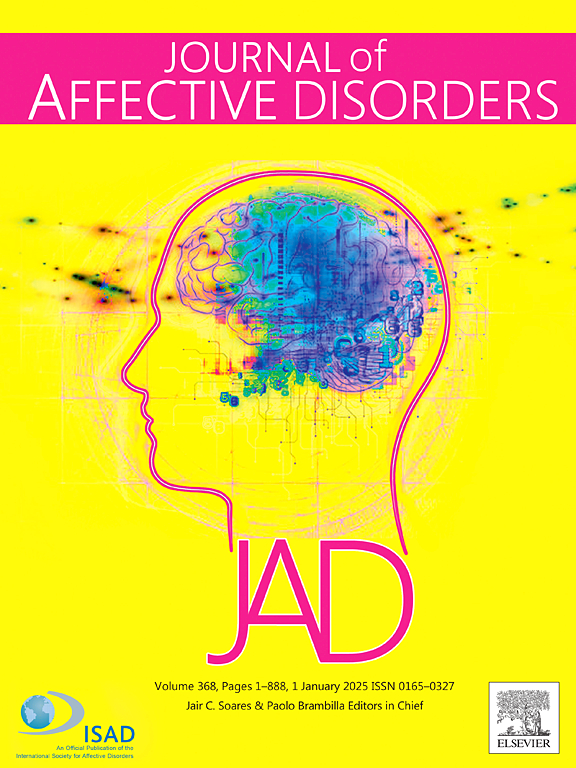Trends in depressive and anxiety disorders among adolescents and young adults (aged 10–24) from 1990 to 2021: A global burden of disease study analysis
IF 4.9
2区 医学
Q1 CLINICAL NEUROLOGY
引用次数: 0
Abstract
Objective
To assess long-term trends in the burden of depression and anxiety among individuals aged 10–24 years from 1990 to 2021, and to examine disparities across socio-demographic levels using data from the Global Burden of Disease (GBD) Study 2019 and 2021.
Methods
We performed a retrospective ecological trend analysis using Joinpoint regression models to estimate the Average Annual Percent Change (AAPC) in incidence and disability-adjusted life years (DALYs). Inequalities across countries were evaluated using the slope index of inequality (SII) and the concentration index (CI). Analyses were stratified by age group, sex, geographic region, country, and Socio-demographic Index (SDI) level.
Results
Between 1990 and 2021, the global AAPC of depression and anxiety disorders ranged from 0.80 % to 0.97 %, with a marked acceleration from 2014 to 2021, peaking in 2019. The burden was consistently higher in females, though the growth rate of male depression was steeper. The fastest increase in depression was observed in the 10–14 age group, and in anxiety among those aged 20–24. Regionally, high-income North America showed the greatest increase in depression, while Andean Latin America exhibited the highest rise in anxiety. High SDI countries experienced greater burden growth, whereas East Asia saw the slowest. Although relative inequality decreased, absolute inequality across countries widened over time.
Conclusions
The burden of depression and anxiety among adolescents and young adults has increased substantially, especially in high SDI countries. These trends vary significantly by sex, age, and region, highlighting the need for context-specific mental health interventions.
1990年至2021年青少年和年轻成人(10-24岁)抑郁和焦虑症的趋势:全球疾病负担研究分析
目的:评估1990年至2021年10-24岁 人群抑郁和焦虑负担的长期趋势,并使用2019年和2021年全球疾病负担(GBD)研究的数据检查不同社会人口水平的差异。方法:采用关节点回归模型进行回顾性生态趋势分析,估计发病率和残疾调整生命年(DALYs)的平均年百分比变化(AAPC)。使用不平等斜率指数(SII)和集中指数(CI)来评估各国之间的不平等。分析按年龄组、性别、地理区域、国家和社会人口指数(SDI)水平进行分层。结果:1990 - 2021年,全球抑郁和焦虑障碍的AAPC范围为0.80 % ~ 0.97 %,2014 - 2021年显著加速,2019年达到峰值。尽管男性抑郁症的增长速度更快,但女性的负担始终更高。10-14岁年龄组的抑郁症和20-24岁年龄组的焦虑症增长最快。从地区来看,高收入的北美地区抑郁症的增长幅度最大,而安第斯山脉的拉丁美洲地区焦虑症的增长幅度最大。高SDI国家的负担增长更大,而东亚的负担增长最慢。虽然相对不平等减少了,但各国之间的绝对不平等随着时间的推移而扩大。结论:青少年和年轻人的抑郁和焦虑负担大幅增加,特别是在高SDI国家。这些趋势因性别、年龄和地区的不同而有很大差异,突出表明需要针对具体情况采取精神卫生干预措施。
本文章由计算机程序翻译,如有差异,请以英文原文为准。
求助全文
约1分钟内获得全文
求助全文
来源期刊

Journal of affective disorders
医学-精神病学
CiteScore
10.90
自引率
6.10%
发文量
1319
审稿时长
9.3 weeks
期刊介绍:
The Journal of Affective Disorders publishes papers concerned with affective disorders in the widest sense: depression, mania, mood spectrum, emotions and personality, anxiety and stress. It is interdisciplinary and aims to bring together different approaches for a diverse readership. Top quality papers will be accepted dealing with any aspect of affective disorders, including neuroimaging, cognitive neurosciences, genetics, molecular biology, experimental and clinical neurosciences, pharmacology, neuroimmunoendocrinology, intervention and treatment trials.
 求助内容:
求助内容: 应助结果提醒方式:
应助结果提醒方式:


